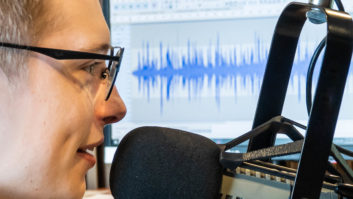Some FM Broadcasters Consider Their Options for Supplemental Audio Services on HD Radio
Last time we considered how new, legitimate music-download services are likely to erode radio-listening time further. Soon after that issue went to press, Apple announced some new features in the next generation of its iTunes service, some of which seem to put traditional radio usage even more squarely in the bull’s eye.
One of these features is called iMix, which allows iTunes users to publish playlists of their favorite songs at the service’s portal, so any other users can preview the music on the list. Other users then can rate the playlist, creating an Amazon.com-like community experience, which stimulates the discovery and subsequent purchase of new music.
Sounds an awful lot like what radio used to do, except that the result is more measurable. No wonder record companies are interested in these services. As a result, it may erode the music industry’s interest in radio, too, just as new digital radio services are emerging.
This can only add fuel to that industry’s current effort to limit listeners’ access to storing music received via HD Radio.
Similar community-building features are appearing in other online music stores, so consumer (and record company) behavior thus engendered could likely become widespread, and eventually mainstream.
Meanwhile, Apple acknowledges that today’s iTunes users are not exclusively downloaders. The service has added another new feature called Radio Charts, by which a radio station can submit its playlist to Apple for inclusion in an iTunes database. Listeners can search this database at the iTunes portal to identify what they heard on a participating station at a given time, then purchase the music if they desire.
So some opportunity for synergy with radio broadcasters exists – although it could be seen as simply providing a way to capture more radio listeners and convert them to iPod/iTunes users (or expand existing iTunes customers’ usage of the service, at the expense of their radio listening time).
Supplemental value
So how can the additional (“supplemental audio program”) channels of service that the HD Radio FM system might provide help radio combat this drain on listernership?
Some FM broadcasters already have started planning for new, second services that would attract or retain audiences. Among these are full-time (or drive-time) traffic and weather services, niche news and information services (e.g., long-form network audio feeds from ESPN, CNN, C-SPAN, Bloomberg, BBC, NPR, etc.); second-language simulcasts (e.g., music or other programming is the same as that presented on the main channel, but DJ/spot breaks are provided in a second language); and completely independent foreign language services.
Some of the most creative thinking on supplemental audio services to date has taken place in public radio circles, stimulated by the NPR-initiated Tomorrow Radio project. Some public stations are developing second-service program schedules that counter-program their main services, as well as those of other public stations in markets where multiple public stations exist.
A few public stations also are considering a return to educational or public-service programming on their supplemental channels, content that has largely disappeared from public radio in recent years. And once HD Radio receivers include supplemental audio service capability, they will make great fundraising premiums.
More to the point in this discussion, supplemental audio services could open the door to the return of “marginal” music formats, or the development of new ones, as the advent of FM did in the 1970s with progressive/underground rock and beautiful music formats.
Some programmers have suggested that supplemental audio service could be considered along the same lines as online radio Webcasting, in that it will have a smaller but more proactive “seeker” audience, while main channels remain the domain of mainstream “surfers.” In this way, supplemental audio channels can help radio remain more relevant in the face of emerging competitive services.
The landscape ahead
It’s also worth noting that while the supplemental audio service concept was instigated by NPR, it seems to be gaining broader traction among commercial broadcasters and, even more important, among regulators. The service specifically was targeted for comment in the FCC’s recent Further Notice of Proposed Rule Making on digital radio, and cited as a significant part of digital radio’s promise in that proceedings accompanying statements from Commissioners Powell, Adelstein and Copps.
Yet several key challenges remain to realization of supplemental audio service.
First is the fact that in the hybrid HD Radio format (which is likely to remain the only environment that broadcasters experience for the foreseeable future, at least on the FM side), supplemental audio only exists as a datacasting service. This implies that it is not covered in the basic license that Ibiquity offers to broadcasters under standard terms. It remains unclear what, if any, additional royalties might be levied on stations that wish to implement supplemental audio services. It is likely, however, that these would not be prohibitive, and commercial broadcasters could be willing to pony up reasonable additional licensing fees, because this is one element of the system that could have some direct, measurable return.
Second, the consideration of supplemental audio as akin to Webcasting also could be taken by the record industry as an opportunity to seek new royalties on published music content used on the service, as it has succeeded in doing in the Webcasting world. Meanwhile, as noted earlier, the music industry is pursuing the establishment of consumer hardware limitations to recording and redistribution of content received via HD Radio services.
Another question is how widespread the ability to receive supplemental audio services will become among HD Radio receivers. It is certainly not included in first generation devices, but when and how available will it become? Will it become a mandatory part of the standard to support, as in DTV multicasting? This is unlikely, but recent comments from chipmakers indicate that it could become a de facto standard feature anyway, just as stereo has become among FM receivers.
Finally, the cited recent actions and statements from the FCC also hint that additional public-service or access requirements might be introduced if incumbent licensees suddenly obtain additional channels. This could create a disincentive among those broadcasters to implement supplemental services, so the resultant chilling effect would serve to harm the public service intention that motivated the proposal. This is another item on which the FCC seeks comment in its current digital radio FNPRM.
The resolution of these issues will weigh heavily on the deployment of digital radio in the United States, and the stakes are quite high. Although it may be difficult to recognize at this stage, supplemental audio functionality may ultimately become the most pivotal element to HD Radio’s success.












